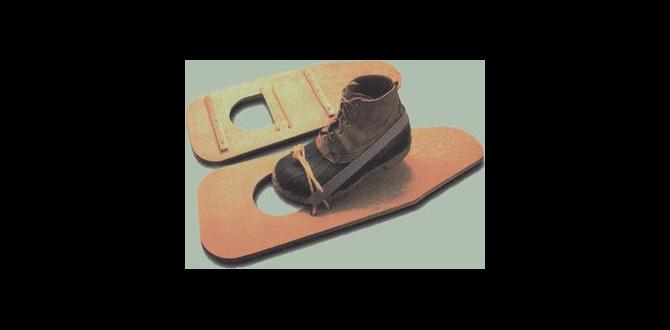Quick Summary: Master how to use a nailer on plywood with simple steps! Choose the right nailer, adjust settings, and shoot nails accurately for strong, secure joints every time. This guide ensures your plywood projects are sturdy and professional.
Hey there, fellow DIYers! Jack Shaffer here, your go-to guy for all things nailers and woodworking. Ever stared at a sheet of plywood and a nail gun, wondering if they were destined for a beautiful, stress-free project together? It can feel a bit daunting at first, right? Especially when you want those plywood panels to connect securely without splitting or buckling. But don’t you worry! With a few simple tips, you’ll be driving nails into plywood like a seasoned pro. We’re going to walk through it step-by-step, making sure you feel confident with every squeeze of the trigger. Ready to build something awesome?
Table of Contents
Why Plywood Projects Need a Nailer (And Why It’s Easier Than You Think!)
Plywood is a DIY superhero. It’s strong, versatile, and relatively affordable, making it perfect for everything from shelving units and cabinet boxes to decorative wall panels and even furniture. But how do you join those big sheets together reliably? Sure, you can screw it, but nails often offer a faster, more cohesive hold, especially when you’re working with thinner plywood or need to create a strong frame.
This is where your nailer comes in! Using a nailer on plywood might sound intimidating, but it’s actually one of the best ways to get a professional-looking finish quickly. The key is understanding your tool and the material. We’ll break down exactly what you need to know so you can nail your projects with confidence.
Choosing the Right Nailer for Plywood
Not all nailers are created equal, and the one you pick can make a big difference in how smoothly your plywood project comes together. For most general woodworking and plywood applications, a few types stand out:
1. Brad Nailer
Brad nailers are fantastic for attaching thinner plywood pieces, trim, or molding where the nail doesn’t need to bear heavy weight. They shoot thin, — hence the name — brad nails that leave a very small hole, making them great for projects where appearance matters and you want minimal filling.
- Pros: Leaves small, easily hidden holes; lightweight; good for delicate work.
- Cons: Not ideal for structural holding power; can struggle with thicker plywood.
- Best For: Attaching cove molding to plywood shelves, small decorative paneling, or securing thin plywood backings.
2. Finish Nailer
A step up from the brad nailer, a finish nailer uses slightly larger nails (called finish nails) that offer more holding power. They are excellent for joining plywood panels for cabinets, smaller furniture pieces, or trim work where a solid connection is needed but you still want a relatively discreet nail hole.
- Pros: Good balance of holding power and minimal visible damage; versatile for many DIY tasks.
- Cons: Larger nail holes than brad nailers; may still not be enough for very heavy-duty structural joints.
- Best For: Assembling cabinet boxes, attaching plywood faces to frames, or securing thicker decorative panels.
3. Framing Nailer
If you’re building something robust like a rough-and-tumble workbench, a shed frame, or any project where structural integrity is paramount, a framing nailer is your best bet. These guns shoot much larger, thicker nails (framing nails) that provide serious holding power. You’ll typically use these for thicker plywood (3/4-inch and up) in structural applications.
- Pros: Excellent holding power for structural work; fast fastening for large projects.
- Cons: Large nail holes; can be overkill (and riskier) for delicate work; heavier tool.
- Best For: Structural frames for plywood cabinets, building subfloors, framing sheds or playsets.
Pro Tip: For beginners working with standard plywood sheets (like 1/2-inch or 3/4-inch for shelves, cabinets, or jigs), a 16-gauge finish nailer is often the sweet spot. It provides good holding power without being too aggressive.
Essential Tools and Materials
Before you start nailing, let’s make sure you have everything you need:
- Your Chosen Nailer: Pneumatic, cordless electric, or battery-powered.
- Air Compressor (if using a pneumatic nailer): Ensure it has a regulator to control pressure.
- Hoses and Fittings (for pneumatic): Make sure they’re compatible and in good condition.
- Nails: The correct size and type for your nailer and project (refer to your nailer’s manual). For plywood, think appropriate length so they don’t blow through the other side!
- Plywood Sheets: Make sure they are cut to size.
- Safety Glasses: Non-negotiable! Always protect your eyes.
- Hearing Protection: Nailers can be loud.
- Work Gloves: For a better grip and protection.
- Measuring Tape and Pencil: For marking your nailing lines.
- Clamps: To hold your plywood pieces firmly in place while you nail.
- Air Duster or Blower (optional): To clear sawdust from your work area.
Step-by-Step: How to Use a Nailer on Plywood Safely and Effectively
Alright, let’s get down to business! Follow these steps to nail your plywood projects like a pro. Remember, safety first, always!
-
GATHER YOUR GEAR & SET UP YOUR WORKSPACE:
- Ensure you’re in a well-ventilated area, free from tripping hazards.
- Lay out all your tools and materials.
- Make sure your plywood pieces are accurately cut and ready to be joined.
-
PUT ON YOUR SAFETY EQUIPMENT:
This is crucial! Always wear safety glasses. Hearing protection is also highly recommended. Gloves can help with grip and hand protection.
-
PREPARE YOUR NAILER:
- For Pneumatic Nailers: Connect your air hose to the nailer and the compressor. Set your compressor’s regulator to the pressure recommended in your nailer’s manual. This is vital! Too much pressure can damage the plywood or drive nails too deep, while too little might not drive them fully. A good starting point for plywood is usually between 70-100 PSI, but always check your tool’s specifications.
- For Cordless/Battery Nailers: Ensure the battery is fully charged and properly inserted. Load the correct type and size of nails into the magazine according to the manufacturer’s instructions.
- Loading Nails: Most nailers have a spring-loaded magazine. Slide the nails into the channel, nose-first, ensuring they are seated correctly. Never force nails.
-
ADJUST NAILER DEPTH SETTING:
This is a critical step for a clean finish. Most nailers have an adjustable depth setting. You want the nail head to sit just slightly below the surface of the plywood (a ‘countersink’), or flush with it. You can usually adjust this via a dial or lever on the nailer. Test it on a scrap piece of plywood first!
Test Firing for Depth: Before firing into your project, fire a test nail into a scrap piece of plywood of the same thickness. Check the depth. If it’s too deep, it might go through the other side or create a large divot. If it’s too shallow, the nail head will be sticking out. Adjust the depth setting and test again until you achieve a perfect countersink or flush finish.
-
POSITION YOUR PLYWOOD PIECES:
Align the edges of the plywood pieces you want to join. Use clamps to hold them securely in place. This prevents the pieces from shifting while you’re nailing, ensuring a tight and accurate joint. Clamping is your best friend for good results!
-
POSITION THE NAILER:
Place the nose of the nailer firmly against the surface of the plywood where you want to drive the nail. Make sure the safety contact tip (the little prong at the end of the nose) is pressed flat against the wood. This activates the firing mechanism.
Important: Always orient the nailer so the nails will drive into the plywood edge or into the supporting framing piece, not across the grain of the face where they are more likely to split the wood.
-
DRIVE THE NAILS:
With the nailer positioned and firmly pressed against the wood, gently squeeze the trigger. The nail will be driven into the plywood. If you’re using a contact trip (bump fire), you can lightly push the nose against the wood and lightly press the trigger to drive each nail. If you’re using sequential trip, you fully press the nose, then pull the trigger.
Nailing Pattern: For good holding power, especially on longer joints, space your nails evenly. For a 4-foot edge, you might use 6-8 nails. Start about an inch from each end and space the rest out. Avoid placing nails too close to the edge of the plywood, as this can cause the veneer to split, especially with thinner sheets. A general rule of thumb is to keep nails at least 1/2 inch from the edge.
-
CHECK EACH NAIL:
After driving each nail, quickly check its depth. If it’s too deep, you may need to adjust pressure or depth settings for the next nail. If it’s too proud, you’ll need to gently tap it flush with a hammer or use a nail set.
-
CONTINUE UNTIL COMPLETE:
Repeat steps 5-8, carefully placing and driving nails along your joint. Work your way around the project, ensuring everything is securely fastened.
-
CLEAN UP AND INSPECT:
Once you’re finished nailing, disconnect the air hose (if pneumatic) or turn off the tool. Store your nailer and materials safely. Inspect your work for any popped nails or areas that might need extra reinforcement. For a smoother finish, you can gently sand down any proud nail heads or fill the small indentations with wood filler or putty.
Nailer Settings & Plywood Thickness: A Quick Guide
Finding the perfect balance for your nailer settings can make all the difference. Here’s a general guide, but always remember to test on scrap wood first!
| Plywood Thickness | Nailer Type (Recommended) | Nail Gauge | Nail Length (Approx.) | PSI (Pneumatic) / Depth Setting | Nail Spacing (Approx.) |
|---|---|---|---|---|---|
| 1/4 inch (6mm) | Brad Nailer | 18-gauge | 3/4 – 1 inch (19-25mm) | Lower PSI (60-80 PSI) or Depth setting at ‘1’ or ‘2’ | 1-2 inches from edge, 3-4 inches between nails |
| 1/2 inch (12mm) | Finish Nailer | 16-gauge | 1 1/4 – 1 1/2 inches (32-38mm) | Medium PSI (70-90 PSI) or Depth setting at ‘3’ or ‘4’ | 1/2 – 1 inch from edge, 2-3 inches between nails |
| 3/4 inch (19mm) | Finish Nailer / Framing Nailer (for structural) | 16-gauge (Finish) / 10-12 gauge (Framing) | 1 1/2 – 2 inches (38-50mm) – Ensure nail does NOT fully penetrate opposite ply! | Medium-High PSI (80-100 PSI) or Depth setting at ‘4’ or ‘5’ (Finish); Check Framing Nailer manual. | 1/2 – 1 inch from edge, 2-3 inches between nails |
Understanding Nail Penetration: A key goal is to have your nails go through the first sheet of plywood and securely into the second sheet (or into the edge of the adjoining piece). For common 1/2-inch or 3/4-inch plywood, a nail that’s about 1 1/4 to 1 1/2 inches long is often perfect. You want enough length for good grip without the nail tip poking out the other side of the board you’re fastening into. For example, when joining two 3/4-inch pieces edge-to-edge, a 2-inch nail is typically appropriate.
Common Plywood Nailing Pitfalls (And How to Avoid Them!)
Even with the best intentions, a few things can go wrong. Here are common issues and their simple fixes:
- Splitting Plywood Edges: This is common, especially with thinner plywood.
- Why it happens: Nails driven too close to the edge, or using nails that are too large for the plywood thickness.
- How to fix: Keep nails at least 1/2 inch from the edge. Use smaller gauge nails (like brad or finish nails) for thinner plywood. Pre-drilling pilot holes extremely close to the edge can also help, though this defeats some of the speed benefit of a nailer. Consider using wood glue in addition to nails for extra adhesion, which helps distribute stress.
- Nails Not Driving Deep Enough: Your project won’t be secure if nails are sticking out.
- Why it happens: Incorrect PSI (too low), depth setting not adjusted, or a dull nailer tip.
- How to fix: Increase the PSI on your compressor (for pneumatic) following your tool’s manual. Adjust the depth setting deeper. Ensure your nailer is properly maintained.
- Nails Driving Too Deep (Over-Driving): Creating large craters in your plywood.
- Why it happens: Incorrect PSI (too high), depth setting too aggressive, or firing into softer plywood varieties.
- How to fix: Decrease PSI. Adjust the depth setting shallower. Always test fire on scrap wood!
- Nail Bending or Jamming: Frustrating and can damage your tool.
- Why it happens: Using the wrong type/size of nail, nails not seated correctly in the magazine, or hitting a knot in the plywood too hard.
- How to fix: Double-check you’re using the exact nails recommended for your nailer. Ensure nails are loaded straight and fully into the groove. If you’re consistently hitting knots, try slightly adjusting your nail placement.
- Plywood Delaminating: The layers of plywood separating.
- Why it happens: Excessive force from the nailer, or nails driven too close to the edge.
- How to fix: Use appropriate PSI and depth settings. Avoid nailing too close to edges. For structural joints, consider screws which can sometimes be more forgiving on layered materials if not over-tightened.
When to Use Glue with Nails
For any joint that needs real strength and durability, don’t skip the wood glue! Nails provide quick fastening, but glue creates a bond that’s often stronger than the wood itself. When you combine wood glue with nails:
- Apply a thin, even layer of wood glue to the edges or surfaces being joined before bringing them together.
- Clamp the pieces tightly together.
- Drive your nails through the glued joint. The nails help hold the pieces securely while the glue dries.
- Wipe away any excess glue that squeezes out with a damp cloth before it dries.
This technique is a game-changer for building cabinet carcasses, furniture frames, and anything else that needs to stand the test of time. For more on wood glues, resources like this Forest Products Laboratory publication offer insights


